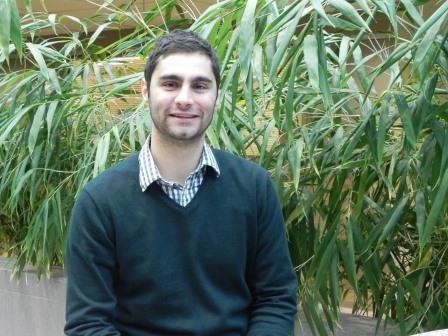Meric Osman is a researcher at the Health Quality Council
Meric Osman joined the Health Quality Council as a research analyst in January 2012 before taking on his current researcher role in June 2014. He has a Bachelor of Arts degree in economics from Bilkent University in Turkey, and a Master of Arts degree in economics, with a specialization in health economics, from the University of Saskatchewan. Below, Meric talks about his work at HQC, what he’s doing when he’s not at work and his love for his family, soccer and soap-making.
You recently co-authored a study with two medical doctors called “Geographical disparities in the burden of ruptured and unruptured abdominal aortic aneurysms in Saskatchewan.” What did the study find?
This study came out of the surgical variations study, which was done as part of the Saskatchewan Surgical Initiative and which uncovered a clustering of abdominal aortic aneurysm (AAA) cases in certain communities. This suggested there may be a need for targeted AAA screening in those communities.
For the AAA study, we looked at a number of new and existing AAA cases by health region from 1996/97 to 2010/11. We observed high AAA prevalence in some areas of the province even after controlling for risk factors, such as age and sex.
In June, we were recognized with an Award of Excellence for our work on the AAA study at the Regina Qu’Appelle Health Region’s eighth annual Research Showcase. Receiving the recognition was confirmation that we are on the right track in our research efforts to inform improvement of health care in Saskatchewan. I believe this project is a perfect example of some of HQC’s core values: Collaboration and Knowledge for Action.
What was your role in the AAA study?
I was mainly responsible for the data portion of the project. I did everything from data extraction and cleaning to the actual analysis that was outlined in the study proposal. I also acted as a “data consultant” to the project. Based on my knowledge of the various administrative health databases HQC has access to and how they link together, I was able to make recommendations to the researchers about how best to analyze the data. At HQC, we often partner with clinicians and researchers on improvement-driven research projects. We bring expertise in data and analysis that complements the clinicians’ and researchers’ clinical and academic knowledge.
You have been doing a lot of work recently on hotspotting. Can you explain this work?
There is a lot of evidence in research literature that suggests a small number of people with complex health issues consume a high proportion of health care resources through frequent emergency department visits and hospitalizations. We are utilizing a data-driven approach that aims to identify and improve the care and health of these patients through personalized case management. The work also aims to reduce health care costs by ensuring people get the right kinds of services they need.
Given our access to many administrative health databases, and our expertise in working with those databases, HQC offered its support in research and measurement to assist this work in Saskatchewan. From the beginning, we have been partnering with the Ministry of Health, clinical experts and health regions to launch pilot programs in Saskatoon Health Region and in Regina Qu’Appelle Health Region.
How do patients and the health system benefit from this?
The patients in this context are recognized as having complex health issues and needs, which results in reoccurring hospitalizations. Their needs are generally not best addressed through traditional emergency department or hospital care. The aim of this work is to provide more appropriate care for these patients through customized case management to better meet their needs. This will also help to ensure more appropriate and effective use of health care and other services. This approach to patient care is a win-win situation for the patients and for the health system.You’ve been at HQC for nearly three years. What is your favourite part of working at HQC?
I love the people and the work we do at HQC. My favourite part is the real-life improvements our work has on the health of Saskatchewan residents.
If you could describe HQC in one word, what would it be?
I would use the word “collaboration.”When you’re not at work, what are you doing?
I have been a board member of Saskatoon Youth Soccer for the last 1.5 years. I also play recreational basketball once a week, which is a lot of fun. When I am at home, I love spending time with my family and my six-month-old daughter. With her there is always something new. Also, I enjoy reading, soap-making, cooking and watching movies.



